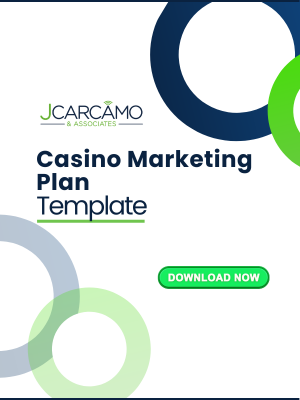For marketing teams at regional casinos, balancing limited resources with ambitious goals necessitates both strategy and creativity. Regional casino marketing demands precision targeting and effective resource management that turns modest budgets into significant results.
The good news? Strategic planning and smart budgeting can produce significant results even with limited resources. These seven proven hacks will help you concentrate your efforts, eliminate waste, and execute with greater clarity, whether you have a full marketing department or just a few energetic team members eager to learn and grow.
Hack #1: Plan in 90-Day Sprints for Agile Casino Budgeting
Annual planning has its place, but locking yourself into rigid 12-month strategies makes it challenging to respond to quick or surprising market changes. Instead, embrace agility through quarterly sprints that allow for more frequent assessment and adjustment.
We used to create massive annual plans that became outdated by February,” explains one marketing director from a Midwest property. “Switching to 90-day sprints allowed us to adapt to competitor moves and capitalize on emerging opportunities without waiting for next year’s budget cycle.
The 90-day approach works because it:
- Forces the prioritization of high-impact initiatives
- Establishes natural checkpoints for evaluation
- Enables you to reallocate resources from underperforming programs
- Keeps your team energized with new challenges each quarter.
For marketing teams at properties located within 100 to 200 miles of multiple competitors, quarterly planning provides flexibility in responding to competitive promotions more nimbly. When your customers visit multiple properties, the ability to quickly counter a competitor’s new offer can be the difference between meeting your goals or watching your players head elsewhere.
Hack #2: Reverse-Engineer Your Marketing Budget from Revenue Goals
Most casino marketing teams begin with last year’s budget and make incremental adjustments as needed for the upcoming year. A more effective approach? Start with your revenue targets and work backward to establish spending priorities.
Begin by identifying your key revenue drivers:
- Which player segments yield the most profitable revenue?
- How are you programming the next 13 weeks to maximize that potential revenue?
- Which promotions have historically delivered the strongest ROI and can help you achieve your revenue goal?
- Which months require the most marketing support based on seasonal patterns?
Then allocate your budget based on potential revenue, rather than departmental precedent.
When analyzing player segments, a regional casino in the Southeast discovered that their mid-tier players (ADT $300-500) responded most profitably to marketing investments. By reallocating 15% of their budget from a lower tier to this segment, they increased overall gaming revenue by 7% without spending an additional dollar and instead investing in more profitable revenue. More importantly, they realized they were over-investing in the lower tier.
For analytically minded marketing VPs focused on demonstrating marketing’s contribution to the bottom line, backward budgeting creates clear ROI metrics that simplify the justification of marketing investments to general managers and other stakeholders.
Hack #3: Boost Accountability with Player Segment Owners
In regional casinos where marketing teams often wear multiple hats, assigning specific player segments to individual team members fosters focus, accountability, and expertise that would otherwise be unattainable.
The segment owner approach works by:
- Establishing clear accountability for segment performance
- Developing a deeper understanding of player behavior patterns
- Building stronger connections between hosts and their assigned players
- Creating events and offers that resonate most with their segment
- Accelerating professional development, particularly for less experienced team members
A segment ownership structure might look like:
- Team member #1: High-value hosted players
- Team member #2: Frequent visitors (more than 2 trips per week)
- Team member #3: Local day-trip customers
- Team member #4: Weekend and destination visitors
Segment ownership fosters natural learning pathways for properties with inexperienced yet motivated marketing teams. New team members can master one player group before expanding their skills to more complex segments, thereby building confidence and expertise along the way.

Hack #4: Save Time Using Evergreen Casino Campaign Templates
Creative burnout is a reality in regional casinos, where small teams must generate fresh promotions and events month after month. Combat this by creating a library of evergreen campaign templates that can be quickly customized for various segments, seasons, or themes.
Basic Template Structure:
- Campaign Name: [Season/Theme] + [Action Word] + [Value Proposition]
- Audience: Primary and secondary segments
- Offer: A clear and compelling value proposition.
- Channels: Primary, secondary, and support channels
- Timeline: 4-week implementation plan
- Success Metrics: 2-3 KPIs for evaluation
Examples of evergreen campaigns include:
- Bounce-back offers triggered by visit patterns
- Scratch cards or pull-tabs
- Birthday and anniversary celebrations, along with jackpot events, featuring escalating offers by tier
- New member accelerator programs
- Dormant player reactivation sequences
When budget constraints limit creative resources, templates ensure consistent quality even during peak periods. One marketing director from a rural property explains: “With just three people on my team, we’d never keep up with constant campaign demands without a template system. It lets us focus our creative energy on the promotions that really need innovative approaches.”
Hack #5: Use Layered Reporting to Spend Smarter
If you aren’t measuring it, you can’t improve it. Regional casinos require a streamlined reporting structure that delivers the right insights at the right intervals without overwhelming the team with data.
3-Tier Reporting Framework:
Tier 1: Daily/Weekly Monitoring (Quick Pulse Checks)
- Daily theo win by segment
- Promotion participation rates
- Database growth metrics
- Competitor activity alerts
Tier 2: Monthly Performance Indicators (Tactical Assessment)
- Player reinvestment by segment
- Campaign ROI comparisons
- Correlation between hotel and gaming revenue
- New player retention rates
Tier 3: Quarterly Strategic Evaluation (Big Picture View)
- Market share analysis
- Lifetime value projections
- Promotional efficiency trends
- Segment profitability mapping
For properties competing in crowded regional markets, layered reporting turns raw numbers into insights that indicate which promotions genuinely drive profitability as opposed to those that simply generate activity.
Hack #6: Hold Monthly Budget Reviews for Real-Time Optimization
Waiting for quarterly reviews to assess budget performance is akin to checking your slot performance only four times a year—you’d miss critical opportunities to optimize. Instead, conduct 30-minute monthly check-ins specifically focused on financial performance.
30-Minute Budget Check-In Template:
- Minutes 1-5: Review the budget against actuals (where are we over or under?)
- Minutes 6-15: Evaluate the ROI of significant promotions from the previous month.
- Minutes 16-25: Identify opportunities for reallocating resources
- Minutes 26-30: Reach agreement on 1-2 specific adjustments for the upcoming month.
The power of this approach comes from making small, consistent adjustments rather than major corrections after it is too late. Regular check-ins create natural touchpoints for general managers focused on property-wide performance to align marketing activities with overall business goals. Consider inviting representatives from operations or F&B to these sessions to ensure all departments understand how marketing investments impact their areas.
Hack #7: The $0 Budget Challenge: Test Your Creativity Without Spending
Sometimes, the most creative solutions emerge when resources are constrained. Challenge your team quarterly: “If we had no marketing budget next month, how would we drive revenue?”
The $0 Budget Challenge forces innovative thinking and often reveals:
- Untapped partnerships with local businesses
- Existing operational assets that could be better leveraged
- Affordable digital strategies with significant impact
- Employee ideas that require no extra spending
Real-World Success Stories:
- A casino partnered with local food trucks for a “Taste of the Town” event, attracting over 2,000 visitors with no marketing costs.
- A property introduced an employee referral program that attracted 120 new players in 30 days.
- A casino launched a user-generated content campaign that boosted social engagement for the price of a single prize.
For properties centered on community, the $0 challenge frequently uncovers significant local partnership opportunities that larger competitors overlook. These genuine community ties can foster loyalty that costly promotions simply cannot purchase.
Small Changes, Big Impact
Implementing these seven budget and planning hacks doesn’t require massive investments or organizational overhauls—just a commitment to working smarter with the resources you have. The most successful regional casino marketers recognize that effective resource management isn’t about having the biggest budget; it’s about strategically allocating what you have to create maximum impact.
Start by selecting one or two hacks that address your property’s most pressing challenges. Perhaps your team would benefit the most from the focus that comes with segment ownership, or maybe your planning process needs the agility of 90-day sprints. Whatever your starting point, these practical approaches can help transform your marketing team’s operations.
Remember that in regional casino marketing, your greatest advantages lie in your deep understanding of local players and your ability to respond swiftly to market changes. These seven hacks are crafted to enhance those strengths while maximizing the return on every marketing dollar you invest.
What budget or planning hack has made the most significant difference at your property?



Recent Comments